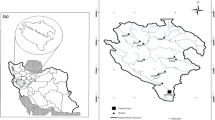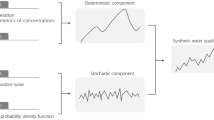Abstract
This paper, the first in a series of two, employs the principle of maximum entropy (POME) via maximum entropy spectral analysis (MESA) to develop a univariate model for long-term streamflow forecasting. Three cases of streamflow forecasting are investigated: forward forecasting, backward forecasting (or reconstruction) and intermittent forecasting (or filling in missing records). Application of the model is discussed in the second paper.
Similar content being viewed by others
References
Beck, M.B. 1978: A comparative study of dynamic models for DO-BOD-Algae interaction in a freshwater river. International Institute of Applied Systems Analysis, Report No. RR-78-19
Bergman, M.J.; Delleur, J.W. 1985a: Kalman filter estimation and prediction of daily streamflows, I. Review, algorithm and simulation experiments. Water Resources Bulletin 21 (5), 815–825
Bergman, M.J.; Delleur, J.W. 1985b: Kalman filter estimation and prediction of daily streamflows, II. Application to the Potomac River. Water Resources Bulletin 21 (5), 826–832
Box, G.E.P.; Jenkins, G. 1976: Time series analysis, forecasting and control. 2nd edition. San Francisco, California: Holden Day
Bras, R.L.; Rodriguez-Iturbe, I. 1985: Random functions and hydrology. Reading, Massachusetts: Addison-Wesley Publishing Company
Brazil, L.E.; Hudlow, M.D. 1981: Calibration procedures used with the National Weather Service river forecast system. In: Haimes, Y.Y.; Kindler, J. (eds.) Water and related resource systems, pp. 457–466. New York: Pergamon Press
Burden, R.L.; Faires, J.D.; Reynolds, A.C. 1979: Numerical analysis. Boston, Massachusetts: Prindle, Weber and Schmidt
Burg, J.P. 1975: Maximum entropy spectral analysis. Ph.D. Thesis, Stanford University, 123 p., Palo Alto, California, University Microfilms, pp. 75–25, 499
Carlson, R.F.; MacCornick, A.J.A.; Watts, D.G. 1970: Application of linear models to four annual stream-flow series. Water Resources Research 6 (4), 1070–1088
Chang, T.J.; Kavvas, M.L.; Delleur, J.W., 1982: Stochastic daily precipitation modeling and daily stream-flow transfer processes. Tech. Report No. 746, Water Resources Research Center, Purdue University, West Lafayette, Indiana
Chatfield, C. 1984: The analysis of time series: An introduction. London, U.K.: Chapman and Hall
Christensen, R.A. 1981: An exploratory application of entropy minimax to weather prediction: estimating the likelihood of multi-year droughts in California. In: Christensen, R.A. (ed.) Entropy minimax source book, Vol. IV: Applications, pp. 495–544. Lincoln, Massachusetts: Entropy Limited
Copper, D.M.; Wood, E.F. 1982a: Identification of multivariate time series and multivariate input-output models. Water Resources Research 18 (4), 937–946
Cooper, D.M.; Wood, E.F. 1982b: Parameter estimation of multiple input-output time series models: Application to rainfall-runoff processes. Water Resources Research 10 (5), 1352–1364
Eilbert R.F.; Christensen, R.A. 1983: Performance of the entropy hydrological forecasts for California water years 1948–1977. Journal of Climate and Applied Meteorology 22, 1654–1657
Georgakakos, K.P.; Bras, R.L. 1980: A statistical linearization approach to real time nonlinear flood routing. Technical Report 256, Ralph M. Parsons Laboratory, Dept. of Civil Engineering, MIT, Cambridge, Massachusetts
Georgakakos, K.P.; Bras, R.L. 1982: Real-time, statistically linearized adaptive flood routing. Water Resources Research 18 (3), 513–524
Gosain, A.K. 1984: Intercomparison of real-time highflow forecasting models for Yamuna catchment. Unpublished Ph.D. dissertation, Indian Institute of Technology, Delhi, India
Hino, M. 1970: Runoff forecasts by linear predictive filter. Journal of Hydraulics Division, ASCE 96 (HY 3), 681–707
Hosking, J.R.M. 1984: Modeling persistence in hydrologic time series using fractional differencing. Water Resources Research 20, 1898–1908
Jaynes, E.T. 1982: On the rationale of maximum entropy methods. Proceedings of IEEE 70 (9), 939–952
Karlsson, M.; Yakovitz, S. 1987a: Rainfall-runoff forecasting methods, old and new. Stochastic Hydrology and Hydraulics 2 (4), 303–318
Karlsson, M.; Hakovitz, S. 1987b: Nearest-neighbor methods for non-parametric rainfall-runoff forecasting. Water Resources Research 23 (7), 1300–1308
Kitanidis, P.K.; Bras, R.L. 1979: Colinearity and stability in the estimation of rainfall-runoff model parameters. Journal of Hydrology 42, 91–108
Kitanidis, P.K.; Bras, R.L. 1980: Real-time forecasting with a conceptual hydrologic model, 2. Applications and results. Water Resources Research 16 (6), 1034–1044
Kitanidis, P.K.; Lara, O.G.; Lane, R.W. 1984: Evaluation of streamflow data collection strategies for alluvial rivers. Journal of Hydrology 72, 85–103
Klemes, V. 1974: The Hurst phenomenon: A puzzle? Water Resources Research 10 (4), 675–688
Klemes, V.; 1982: Empirical and causal models in hydrology. In: Fiering, M.B. (ed.) Scientific basis of water resources management, pp. 95–104. Washington, D.C.: National Academy Press
Krstanovic, P.F.; Singh, V.P. 1987: A multivariate stochastic flood analysis using entropy. In: Singh, V.P. Hydrologic frequency modeling, pp. 515–539. Dordrecht, Holland: D. Reidel Publishing Co.
Krstanovic, P.F.; Singh, V.P. 1988: Application of entropy theory to multivariate hydrologic analysis. Technical Report WRR9, Dept. of Civil Engineering, Louisiana State University, Baton Rouge, Louisiana
Krzysztofowitz, R. 1983: A Bayesian Markov model of the flood forecast process. Water Resources Research 19 (6), 1455–1465
Krzysztofowitz, R. 1985: Bayesian models of forecasted time series. Water Resources Bulletin 21 (5), 805–814
Krzysztofowitz, R.; Davis, D.R. 1983: A methodology for evaluation of flood forecasts-response systems. Water Resources Research 19 (6), 1423–1454
Lawrence, A.J.; Kottegoda, N.T. 1977: Stochastic modeling of riverflow time series (with discussion). Journal Royal Statistical Society, Series A 140, 1–47
Levinson, N. 1946: The Wiener rms criterion in filter design and prediction. Journal of Mathematical Physics 25, 261–278
Mandelbrot, B.B.; Wallis, J.R. 1968: Noah, Joseph and operational hydrology. Water Resources Research 4, 908–918
Mandelbrot, B.B.; Wallis, J.R. 1969: Computer experiments with fractional Gaussian noises. Water Resources Research 5, 321–340
McLeod, A.J.; Hipel, K.W. 1978: Preservation of the rescaled adjusted range, 1. A reassessment of the Hurst phenomenon. Water Resources Research 14 (3), 491–508
Nemec, J. 1986: Design and operation of forecasting operational real-time hydrological systems (FORTH). In: Kraijenhoff, D.A.; Moll, J.R. (eds.) River flow modeling and forecasting, pp. 299–327. Dordrecht, Holland: D. Reidel Publishing Co.
O'Connell, P.E. 1974: Stochastic modeling of long-term persistence in streamflow sequences. Ph.D. Thesis, Dept. of Civil Engineering, Imperical College, London, U.K.
Padmanabhan, G.; Rao, A.R. 1986: Maximum entropy spectra of some rainfall and river flow time series from southern and central India. Theoretical and Applied Climatology 37, 63–73
Padmanabhan, G.; Rao, A.R. 1988: Maximum entropy spectral analysis of hydrologic data. Water Resources Research 24 (9), 1519–1533
Potter, K.W. 1976: Evidence for nonstationarity as a physical explanation of the Hurst phenomenon. Water Resources Research 12, 1047–1052
Puente, C.E.; Bras, R.L. 1987: Application of nonlinear filtering in the real-time forecasting of river flows. Water Resources Research 23 (4), 675–682
Salas, J.D.; Delleur, J.W.; Yevjevich, V.; Lane, W.L. 1980: Applied modeling of hydrologic times series. Water Resources Publications, Littleton, Colorado
Schultz, G.A. 1986: Introduction. In: Kraijenhoff, D.A.; Moll, J.R. (eds.) River flow modeling and forecasting, pp. 1–10. Dordrecht, Holland: D. Reidel Publishing Company
Sorooshian, S. 1983: Surface water hydrology: on line estimation. Reviews of Geophysics and Space Physics 21 (3), 706–721
Sorooshian, S.; Gupta, V.K.; Fulton, Y.L. 1982: Parameter estimation of conceptual rainfall-runoff models assuming autocorrelated streamflow data errors — a case study. In: Singh, V.P. (ed.) Statistical analysis of rainfall and runoff, pp. 491–504. Water Resources Publications, Littleton, Colorado
Souza, R.C. 1978: A Bayesian entropy approach to forecasting. Ph.D. Thesis, University of Warwick, Coventry, U.K.
Souza, R.C. 1981: A Bayesian entropy approach to forecasting: the multistate model. In: Anderson, O. D. and Perryman, M. R. (eds.) Time series analysis, pp. 535–542. Amsterdam, Holland: North Holland Publishing Company
Souza, R.C. 1982: A Bayesian entropy approach to forecasting: the Binomial Beta model. In: Anderson, O. D. and Perryman, M. R. (eds.) Time series analysis, pp. 475–486. Amsterdam, Holland: North Holland Publishing Company
Souza, R.C. 1983: A general Bayesian formulation for the steady-state model. In: Anderson, O.D. (ed.) Time series analysis: Theory and practice III, pp. 43–50. Amsterdam, Holland: North Holland Publishing Company
Van den Boss, A. 1971: Alternative interpretation of maximum entropy spectral analysis. IEEE Transactions on Information Theory IT-17, 493–494
Thomas, H.A.; Fiering, M. B. 1962: Mathematical synthesis of streamflow sequences for the analysis of river basins by simulation. In: Mass, M. et al. (eds.) Design of water resources systems, pp. 459–463. Cambridge, Massachusetts: Harvard University Press
Wiener, N. 1950: Extrapolation, interpolation and smoothing of stationary time series with engineering application. New York, New York: John Wiley and Sons, Inc.
WMO. 1974: International glossary of hydrology. UNESCO and WMO, Geneve, Switzerland
WMO, 1975: Intercomparison of conceptual models used in operational hydrologic forecasting. Operational Hydrology Report No. 7, Secretariat of WHO, Geneva, Switzerland
WMO, 1983: Guide to hydrological practice. WMO, No. 168, 4th edition, WMO, Geneve, Switzerland
Yakowitz, S. 1979: A nonparametric Markov model for daily river flow. Water Resources Research 15 (5), 1035–1043
Yakowitz, S. 1985: Markov flood models and the flood warning program. Water Resources Research 21 (1), 81–88
Yevjevich, V. 1963: Fluctuations of wet and years (Part I), Research data assembly and mathematical models. Hydrology Paper I, Colorado State University, Fort Collins, Colorado
Young, P.C. 1974: Recursive approaches to time series analysis. Bulletin Institute Math. Application 10, 209–224
Young, P.C. 1986: Time series methods and recursive estimation of hydrological system analysis. In: Kraijenhoff, D.A. and Moll, J.R. (eds.) River flow modeling and forecasting, pp. 129–180. Dordrecht, Holland: D. Reidel Publishing Company
Author information
Authors and Affiliations
Rights and permissions
About this article
Cite this article
Krstanovic, P.F., Singh, V.P. A univariate model for long-term streamflow forecasting. Stochastic Hydrol Hydraul 5, 173–188 (1991). https://doi.org/10.1007/BF01544056
Accepted:
Issue Date:
DOI: https://doi.org/10.1007/BF01544056




